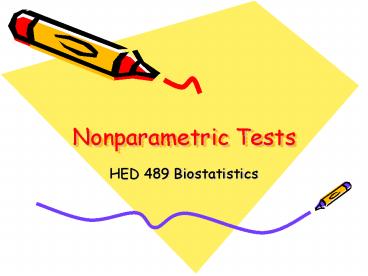Nonparametric Tests - PowerPoint PPT Presentation
1 / 11
Title:
Nonparametric Tests
Description:
You will remember that two of the major requirements to use parametric ... formulas are set up so that you can punch in your own data and it should ... – PowerPoint PPT presentation
Number of Views:194
Avg rating:3.0/5.0
Title: Nonparametric Tests
1
Nonparametric Tests
- HED 489 Biostatistics
2
- You will remember that two of the major
requirements to use parametric statistical tests
are interval or ratio data and a normal
distribution. However, there are many instances
when you will want to analyze nominal or ordinal
data, or when you are concerned about the shape
of the distribution of your data. Under those
circumstances, nonparametric statistics will save
your life! - In addition to not requiring interval data,
nonparametric statistics do not assume any
particular distribution. They are often referred
to as "distribution-free" tests. As a group,
nonparametric tests are also considered to be
more conservative (less power and higher type II
error) than their parametric equivalents. Because
it's harder to achieve statistical significance
using nonparametric tests, you can be more
confident of the results if your data are
significant. In other words, all other things
being equal, your risk of a Type I error is less
with nonparametric than parametric tests.
3
Non-parametric Statistics
Difference Tests
Relationship Tests
Causal Tests
Brown Mood
chi-square
chi-square
Spearman Rank- Order Correlation
Mann-Whitney U
Wilcoxon Sign test
Kendalls tau
Kruskall-Wallis Analysis of Variance
As you can see, there are nonparametric
equivalents to parametric tests of difference,
relationship, and cause-effect. Some of these
tests require at least ordinal data, while others
can be used with interval data. I'll give you a
grid at the end of our discussion of
nonparametric tests that you can use. We're
going to cover chi-square, which is a test you
can use to test differences or relationships
Mann-Whitney U, a t-test equivalent Friedman's
ANOVA and two nonparametric correlation
testsSpearman and Kendall.
4
Follow the Formula
- Click here to follow the formula in Excel. Note
that this is saved as a read-only file. The
reason being is that the formulas are set up so
that you can punch in your own data and it should
(theoretically) calculate your results. - Note that you will be cued to go to the next
Step. - Also, you may see cells with the symbol
in it. This means that the number is too large
to show in the cell. Merely go to the top of the
column of the cell and drag the right line of the
cell so that it is wider.
5
Use this example
Use the formula in chi2.xls to calculate if there
is a significant difference.
6
Complex Chi-Square and Contingency Tables
- When there are more than 2 groups on either
variables, the complex chi-square can be used to
test the hypothesis of no relationship between
the variables. If the chi-square test shows that
there is almost likely a relationship between the
variables, then the contingency coefficient can
be computed to give an indication of the degree
of the relationship. Note, if chi-square reveals
no significance, theres no need to run the
contingency coefficient.
7
Contingency Tables and Odds Ratios
- From contingency tables, one could also calculate
odds ratios. - OR(A/C)/(B/D)
- OR(AD)/(BC)
8
- Like with the 2 x 2 table chi-square, lets work
through this via Excel. Click here to go to that
spreadsheet.
9
- OK, thats it for chi-square. Again, this is
used for frequency (nominal or ordinal) data.
10
Assignment 15a
- Determine the relationship of the following
information - Download template
15b next slide
11
Assignment 15b































